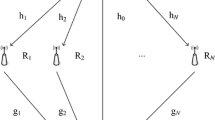Abstract
In this paper, we investigate the outage probability (OP) of a hybrid satellite and terrestrial cooperative network (HSTCN) with the terrestrial relay having multiple antennas. Here, it is assumed that the satellite channel undergoes the shadowed-Rician fading, while terrestrial channel follows correlated Rayleigh fading. By supposing that statistic channel state information (CSI) of relay-destination link is available at the relay, we first obtain the end-to-end output signal-to-noise ratio (SNR) expression of the HSTCN. Then, the closed-form expressions of the outage probability for the considered system are derived, where two combining schemes, namely, selection combing (SC) and maximal-ratio combining (MRC) protocols are utilized at the destination to combine signals form the satellite and relay. Finally, numerical results are given to validity of the OP analysis, and reveal the performance difference of the two combining schemes.
Supported in part by the Key International Cooperation Research Project under Grant 61720106003, in part by National Natural Science Foundation of China under Grant 61801234 and 61271255.
Access this chapter
Tax calculation will be finalised at checkout
Purchases are for personal use only
Similar content being viewed by others
References
Lin, M., Lin, Z., et al.: Joint beamforming for secure communication in cognitive satellite terrestrial networks. IEEE J. Sel. Areas Commun. 36(5), 1017–1029 (2018)
Paolo, C., Giovanni, G., Sastri, K.: A survey on mobile satellite systems. Int. J. Satellite Commun. Netw. 28(1), 29–57 (2010)
Bhatnagar, M.R., Arti, M.K.: Performance analysis of AF based hybrid satellite-terrestrial cooperative network over generalized fading channels. IEEE Commun. Lett. 17(10), 1912–1915 (2013)
Huang, Q., Lin, M., An, K., Ouyang, J., Zhu, W.: Secrecy performance of hybrid satellite-terrestrial relay networks in the presence of multiple eavesdroppers. IET Commun. 12(1), 26–34 (2018)
An, K., Lin, M., Liang, T., et al.: Performance analysis of multi-antenna hybrid satellite-terrestrial relay networks in the presence of interference. IEEE Trans. Commun. 63(11), 4390–4404 (2015)
Zhao, Y., Chen, H., Xie, L., Wang, K.: Exact and asymptotic ergodic capacity analysis of the hybrid satellite-terrestrial cooperative system over generalised fading channels. IET Commun. 12(11), 1342–1350 (2018)
Lin, Z., Lin, M., et al.: Robust secure beamforming for 5G cellular networks coexisting with satellite networks. IEEE J. Sel. Areas Commun. 36(4), 932–945 (2018)
Arti, M.K., Bhatnagar, M.R.: Beamforming and combining in hybrid satellite-terrestrial cooperative systems. IEEE Commun. Lett. 18(3), 483–486 (2014)
Sreng, S., Escrig, B., Boucheret, M.L.: Exact symbol error probability of hybrid/integrated satellite-terrestrial cooperative network. IEEE Trans. Wirel. Commun. 12(3), 1310–1319 (2013)
Ju, M.C., Kim, I.M., Dong, I.K.: Joint relay selection and relay ordering for DF-based cooperative relay networks. IEEE Trans. Commun. 60(4), 908–915 (2012)
An, K., Ouyang, J., Lin, M., et al.: Outage analysis of multi-antenna cognitive hybrid satellite-terrestrial relay networks with beamforming. IEEE Commun. Lett. 19(7), 1157–1160 (2015)
Miridakis, N.I., Vergados, D.D., Michalas, A.: Dual-hop communication over a satellite relay and shadowed Rician channels. IEEE Trans. Veh. Technol. 64(9), 4031–4040 (2015)
Abdi, A., Lau, W.C., Alouini, M.S., Kaveh, M.: A new simple model for land mobile satellite channels: first- and second-order statistics. IEEE Trans. Wirel. Commun. 2(3), 519–528 (2003)
Gradshteyn, I.S., Ryzhik, I.M.: Table of Integrals, Series, and Products. Academic Press, San Diego (2010)
Lin, M., Yang, L., Zhu, W.P., et al.: An open-loop adaptive space-time transmit scheme for correlated fading channels. IEEE J. Sel. Topics Sig. Process. 12(2), 147–158 (2008)
Dakdouki, A.S., Tabulo, M.: On the eigenvalue distribution of smart-antenna arrays in wireless communication systems. Antennas Propag. Mag. IEEE 46(4), 158–167 (2004)
Lin, M., Ouyang, J., Zhu, W.P.: Joint beamforming and power control for device-to-device communications underlaying cellular networks. IEEE J. Sel. Areas Commun. 34(1), 138–150 (2016)
Author information
Authors and Affiliations
Corresponding author
Editor information
Editors and Affiliations
Rights and permissions
Copyright information
© 2019 ICST Institute for Computer Sciences, Social Informatics and Telecommunications Engineering
About this paper
Cite this paper
Cheng, G., Lin, Z., Lin, M., Huang, Q., Ouyang, J. (2019). Outage Probability Analysis for Hybrid Satellite and Terrestrial Network with Different Combining Schemes. In: Jia, M., Guo, Q., Meng, W. (eds) Wireless and Satellite Systems. WiSATS 2019. Lecture Notes of the Institute for Computer Sciences, Social Informatics and Telecommunications Engineering, vol 281. Springer, Cham. https://doi.org/10.1007/978-3-030-19156-6_45
Download citation
DOI: https://doi.org/10.1007/978-3-030-19156-6_45
Published:
Publisher Name: Springer, Cham
Print ISBN: 978-3-030-19155-9
Online ISBN: 978-3-030-19156-6
eBook Packages: Computer ScienceComputer Science (R0)




